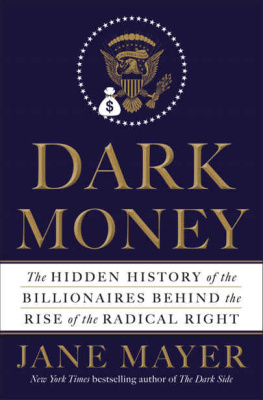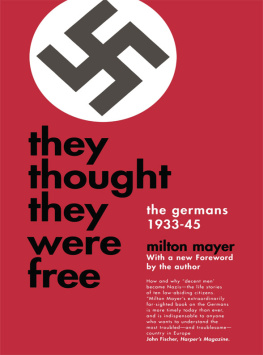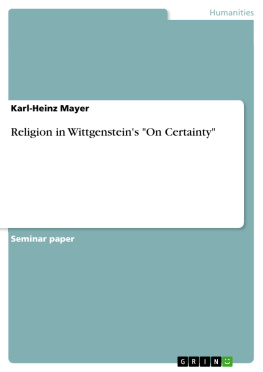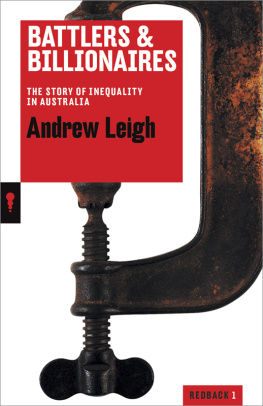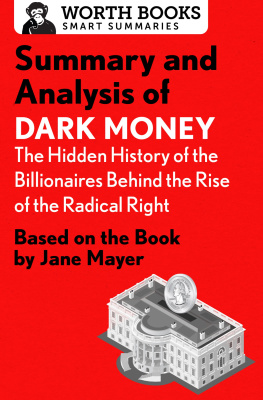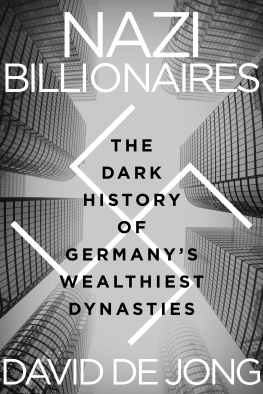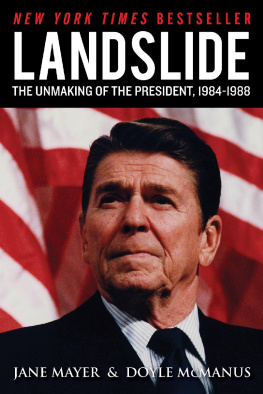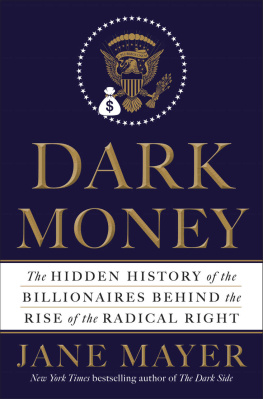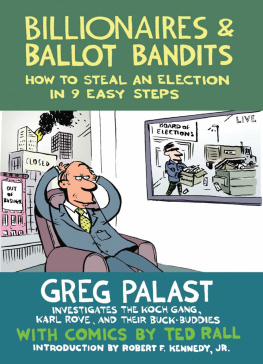ALSO BY JANE MAYER
The Dark Side: The Inside Story of How the War on Terror Turned into a War on American Ideals
Strange Justice: The Selling of Clarence Thomas
(with Jill Abramson)
Landslide: The Unmaking of the President, 19841988
(with Doyle McManus)
Copyright 2016 by Jane Mayer
All rights reserved. Published in the United States by Doubleday, a division of Penguin Random House LLC, New York, and distributed in Canada by Random House of Canada, a division of Penguin Random House Canada Ltd., Toronto.
www.doubleday.com
DOUBLEDAY and the portrayal of an anchor with a dolphin are registered trademarks of Penguin Random House LLC.
Cover design by John Fontana
Cover illustrations: (seal) George Nazlis / Alamy; (money bag) In-Finity / Shutterstock
Library of Congress Control Number: 2015957180
ISBN: 978-0-385-53559-5 (hardcover)
ISBN: 978-0-385-53560-1 (eBook)
eBook ISBN9780385535601
v4.1
a
FOR BILL HAMILTON:
Everyone needs an editor,
but not everyone is lucky enough to marry one.
Thank you for always being there with just the right words.
We must make our choice. We may have democracy, or we may have wealth concentrated in the hands of a few, but we cant have both.
Louis Brandeis
CONTENTS
PART ONE:
WEAPONIZING PHILANTHROPY: THE WAR OF IDEAS,
19702008
PART TWO:
SECRET SPONSORS: COVERT OPERATIONS,
20092010
PART THREE:
PRIVATIZING POLITICS: TOTAL COMBAT,
20112014
INTRODUCTION
The Investors
On January 20, 2009, the eyes of the country were on Washington, where over a million cheering celebrants crowded the National Mall to witness the inauguration of the first African-American president. So many supporters streamed in from all across the nation that for twenty-four hours they nearly doubled Washingtons population. Inaugurations are always moving celebrations of the most basic democratic process, the peaceful transfer of power, but this one was especially euphoric. The countrys most famous and iconic musicians, from the Queen of Soul, Aretha Franklin, to the cellist Yo-Yo Ma, gave soaring performances to mark the occasion. Celebrities and dignitaries pulled strings to get seats. Excitement was so feverish that the Democratic political consultant James Carville was predicting a long-term political realignment in which the Democrats will remain in power for the next forty years.
But on the other side of the country during the last weekend in January 2009, another kind of gathering was under way, of a group of activists who aimed to do all they could to nullify the results of the recent election. In Indian Wells, a California desert town on the outskirts of Palm Springs, one polished sports utility vehicle after the next cruised down the long, palm-lined drive of the Renaissance Esmeralda Resort and Spa. Stepping out onto the curb, as bellboys darted for the luggage, were some of Americas most ardent conservatives, many of whom represented the nations most powerfully entrenched business interests. It would be hard to conjure a richer tableau of the good life than the one greeting them. Overhead, the sky was a brilliant azure. In the distance, the foothills of the Santa Rosa Mountains rose steeply from the Coachella Valley, creating a stunning backdrop of ever-changing hues. Velvety green lawns stretched as far as the eye could see, meandering toward a neighboring thirty-six-hole golf course. Swimming pools, one with a man-made sandy beach, were surrounded by chaises and intimate, curtained pavilions. As dusk fell, countless tea lights and tiki torches magically lit the walkways and flower beds.
B ut inside the hotels dining room, the mood was grim, as if these luxuries merely highlighted how much the group gathered there had to lose. The guests meeting at the resort that weekend included many of the biggest winners during the eight years of George W. Bushs presidency. There were billionaire businessmen, heirs to some of Americas greatest dynastic fortunes, right-wing media moguls, conservative elected officials, and savvy political operatives who had made handsome livings helping their patrons win and hold power. There were also eloquent writers and publicists, whose work at think tanks, advocacy groups, and countless publications was quietly subsidized by corporate interests. The guests of honor, though, were the potential political donorsor investors, as they referred to themselveswhose checkbooks would be sorely needed for the project at hand.
The group had been summoned that weekend not by the leader of a recognized opposition party but rather by a private citizen, Charles Koch. In his seventies, he was white-haired but youthfully fit and very much in charge of Koch Industries, a conglomerate headquartered in Wichita, Kansas. The company had grown spectacularly since its founder, Charless father, Fred, had died in 1967, and he and his brother David took charge, buying out their two other brothers. Charles and Davidoften referred to as the Koch brothersowned virtually all of what had become under their leadership the second-largest private company in America. They owned four thousand miles of pipelines, oil refineries in Alaska, Texas, and Minnesota, the Georgia-Pacific lumber and paper company, coal, and chemicals, and they were huge traders in commodity futures, among other businesses. The companys consistent profitability had made the two brothers the sixth- and seventh-wealthiest men in the world. Each was worth an estimated $14 billion in 2009. Charles, the elder brother, was a man of unusual drive, accustomed to getting his way. What he wanted that weekend was to enlist his fellow conservatives in a daunting task: stopping the Obama administration from implementing Democratic policies that the American public had voted for but that he regarded as catastrophic.
Given the size of their fortunes, Charles and David Koch automatically had extraordinary influence. But for many years, they had magnified their reach further by joining forces with a small and intensely ideological group of like-minded political allies, many of whose personal fortunes were also unfathomably large. This faction hoped to use their wealth to advance a strain of conservative libertarian politics that was so far out on the political fringe as recently as 1980, when David Koch ran for vice president of the United States on the Libertarian Party ticket, it received only 1 percent of the American vote. At the time, the conservative icon William F. Buckley Jr. dismissed their views as Anarcho-Totalitarianism.
The Kochs failed at the ballot box in 1980, but instead of accepting Americas verdict, they set out to change how it voted. They used their fortune to impose their minority views on the majority by other means. In the years since they were trounced at the polls, they poured hundreds of millions of dollars into a stealthy effort to move their political views from the fringe to the center of American political life. With the same foresight and perseverance with which they invested in their businesses, they funded and built a daunting national political machine. As far back as 1976, Charles Koch, who was trained as an engineer, began planning a movement that could sweep the country. As a former member of the John Birch Society, he had a radical goal. In 1978, he declared, Our

